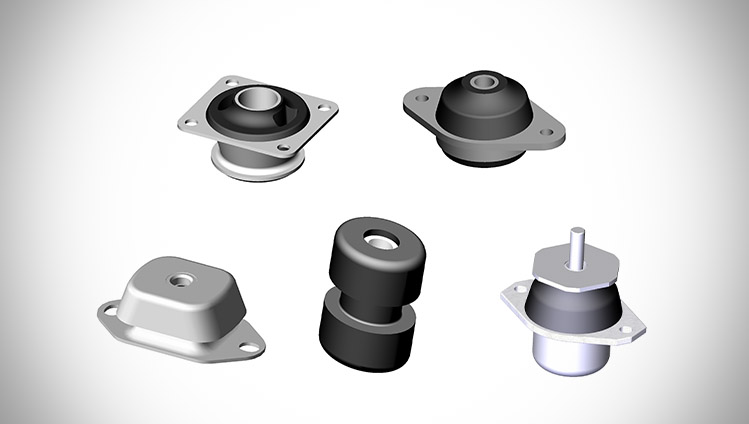In industrial operations, equipment reliability and performance are critical for maintaining productivity and reducing downtime. While attention is often focused on engines, gearboxes, and other core machinery components, a seemingly minor part—the engine mount—can be a silent contributor to operational failures and rising maintenance expenses when neglected.
Engine mounts serve as the critical connection between the engine and the chassis or frame of the machine. They absorb vibrations, reduce noise, and ensure the engine remains properly aligned during operation. When engine mounts wear out or fail, the effects can ripple through the entire system, leading to both direct and indirect costs that often go unnoticed until serious damage is done.
Proactive maintenance and timely replacement of worn engine mount components are essential to ensure long-term operational health. Neglecting this small but vital part can introduce a range of issues, from decreased efficiency to major mechanical failures.
Increased Vibrations and Equipment Fatigue
One of the most immediate consequences of deteriorating engine mounts is an increase in vibration levels throughout the machinery. Mounts are specifically designed to isolate engine vibrations, and when they become worn, this isolation is compromised.
Uncontrolled vibrations can lead to fatigue in other structural components, accelerated wear in belts, pulleys, and joints, and eventual failure of surrounding parts. Not only does this create a more uncomfortable and noisy working environment, but it also shortens the lifespan of the entire system.
Misalignment and Damage to Connected Systems
Worn engine mounts can allow the engine to shift from its intended position, resulting in misalignment. Misalignment can lead to a domino effect of problems—couplings may not line up properly, belts may slip or snap, and drivetrain components can be placed under uneven stress.
Over time, this puts additional strain on bearings, shafts, and seals, leading to frequent breakdowns and higher repair costs. What might have been a simple engine mount replacement can quickly escalate into a full-system overhaul.
Reduced Operational Efficiency
When the engine is not securely held in place, its performance can suffer. Mount degradation can lead to power loss through inefficient energy transmission, delayed responses from powered systems, and increased fuel consumption due to mechanical resistance or poor engine orientation.
For industries that rely on continuous operation, such as manufacturing, logistics, or power generation, even minor efficiency losses can translate into significant costs over time, both in terms of energy usage and reduced output.
Increased Maintenance and Downtime
Ignoring the health of your engine mounts typically leads to more frequent and unpredictable maintenance needs. Unplanned downtime is often far more expensive than routine service, especially when it interrupts production schedules or compromises service delivery.
Additionally, when engine mount issues go unnoticed, technicians may spend valuable time troubleshooting the symptoms—such as excessive vibration or abnormal noise—without addressing the actual cause. This can lead to multiple repair cycles and inflated labor costs.
Safety Risks and Regulatory Concerns
Neglected engine mounts can introduce safety hazards, especially in environments with heavy-duty machinery or vehicles. A loose or shifting engine can compromise the structural integrity of equipment, pose fire risks due to fluid line stress, or lead to sudden failures in high-stakes operations.
In regulated industries such as mining, oil and gas, or transportation, such failures can result in not only operational loss but also penalties for non-compliance with safety standards.
Compromised Asset Value
Machinery that has suffered from prolonged vibration, misalignment, and mechanical strain due to faulty engine mounts will often show signs of accelerated aging. This can reduce resale value, increase insurance costs, and create a poor maintenance record—all of which affect the bottom line.
Routine inspection and timely replacement of engine mounts can significantly extend equipment lifespan and preserve asset value, ensuring a better return on investment over the long term.
Early Detection and Preventive Maintenance
The good news is that these hidden costs are largely avoidable through a proactive maintenance strategy. Regularly inspecting engine mounts for signs of wear—such as cracks, hardening, or deformation—and replacing them as part of scheduled maintenance can prevent more serious issues.
Operators should also pay attention to subtle changes like increased noise, unusual vibration patterns, or movement in engine components. These signs often point to early-stage mount degradation and should trigger a closer inspection.
Conclusion
While engine mount components may seem insignificant compared to the engine itself, their condition has a substantial impact on the performance, longevity, and safety of industrial equipment. The hidden costs of ignoring engine mount health extend beyond the parts themselves, affecting virtually every connected system and driving up long-term operational expenses.
Investing in regular inspection and timely replacement of these vital components is not just good maintenance practice—it’s a strategic move to protect productivity, reduce costs, and ensure operational resilience in harsh industrial environments.
